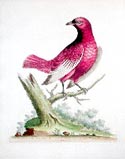Techniques and Innovations
Cudbear and Pompadour
1
There are two methods of extracting these Red colours from the Archil. The first is by incorporating some Acid in the Composition itself that is made Use of to Reduce this Plant to a paste . . . I have been Assured it may be made Violet and even Blue, which probably is done by the Mixture of some Alkalis, but I must confess I could not succeed in it, although I made above twenty trials for that purpose.
James Haigh, The Dyer's Assistant (Leeds, 1778), 199.
In 1758, Cuthbert Gordon received a British patent for a substance he called cudbear, the result of a new processing method he developed for the traditional dyestuff orchil. His technique improved the stability of the popular but fragile violets and purples this lichen produced.1 Gordon, who was a merchant, and his brother, a coppersmith, formed a partnership to sell cudbear, supplying printers and dyers throughout Britain. In 1765, their firm offered a color sample card that included 78 "cudbear colors," ranging through all the red-purples to the violet-blues that you might expect from a coloring material well known to scientists as an acid-base color indicator.2 reference The timing of the development and use of this new coloring process makes it fitting, and perhaps not coincidental, that cudbear could be used to produce pompadour, a fashionable color that first appeared in Britain in the mid-1750s.2 Web Link
As the name for a color, pompadour disappears and reappears from color lists until the early twentieth century with no remarkable regularity. Like nankeen reference, it was clearly not one color but several. Color charts and other descriptions indicate that pompadour could range from a deep purplish-brick color to a silvery pink, and it was used for textiles, paints, and porcelain. 3
The origins of the name pompadour are as difficult to pin down as the color. Suggestions that it was a favorite of Mme de Pompadour have been shown to be untrue: Pompadour may be the color of the drapery in François-Hubert Drouais's portrait of the marquise now at the National Gallery in London, or it may be the pinks in her skirt, or neither. Web Link A color called rose pompadour appeared on the palettes at the Sèvres ceramic manufacture about the time of Gordon's patent and potpourri vases made at Vincennes manufacture were know as pompadours. George Edwards's Natural History of Birds (1759) includes a Pompadore, a bird native to South America with purple-red plumage, but the origins of its name are similarly obscure.
^topNotes:
Note 1: "A Dye . . . Called Cudbear" English Patent no. 727 issued to George Gordon and Cuthbert Gordon, (12 August 1758); Cuthbert Gordon, Memorial of Mr. Cuthbert Gordon, Relative to the Discovery and Use of Cudbear and Other Dying Wares (n.l., c. 1785). back
Note 2: C. Gordon to the Chemistry Committee, (letter with sample card), 26 May 1761, [R]SA PR.GE/110/11/20; "The Method of Dying Silk Wool or Cotton with Cudbear," 26 May 1761, [R]SA PR.GE/110/11/43. back
Note 3: The Oxford English Dictionary Online (accessed 10 November 2004) lists 1756 as the earliest use of pompadour as a color name. back
Note 4: See also Howard Coutts, "A Chelsea Derby Vase and Its Sources," Derby Porcelain International Society Newsletter 18 (May 1990): 22–30. back


